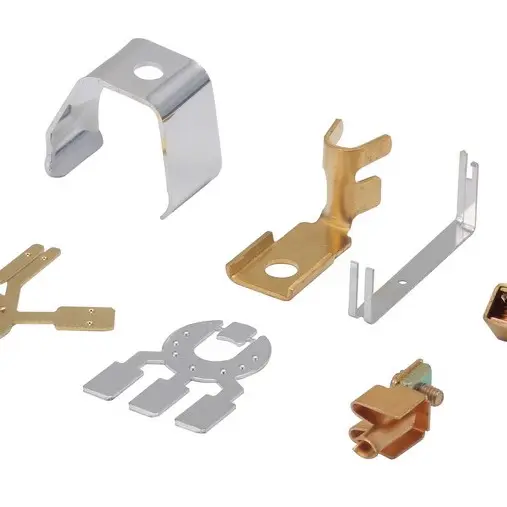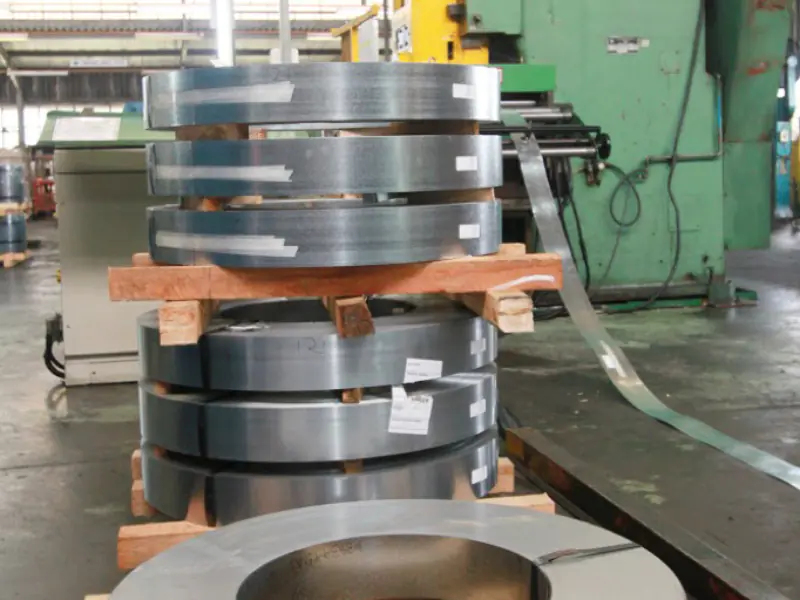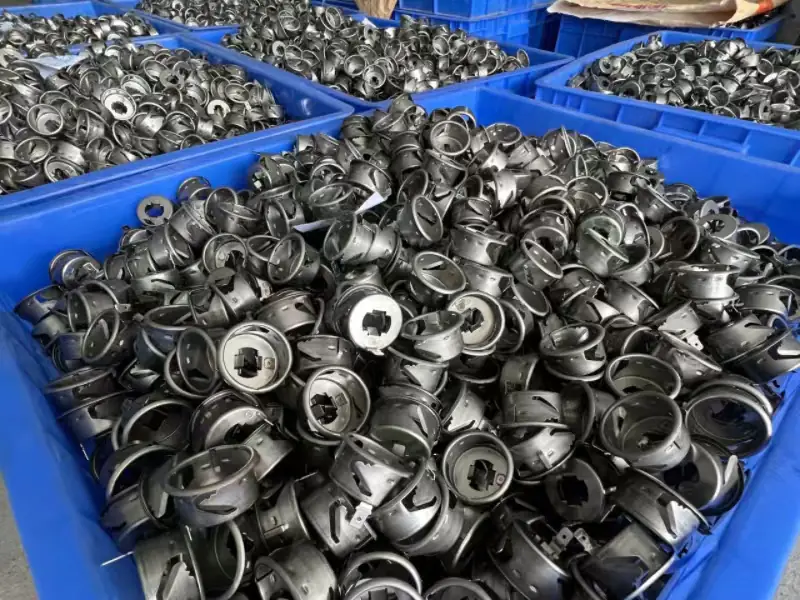-
No.66 Gaojia, aldea de Xingfu, ciudad de Sanqi, Yuyao, Ningbo, China
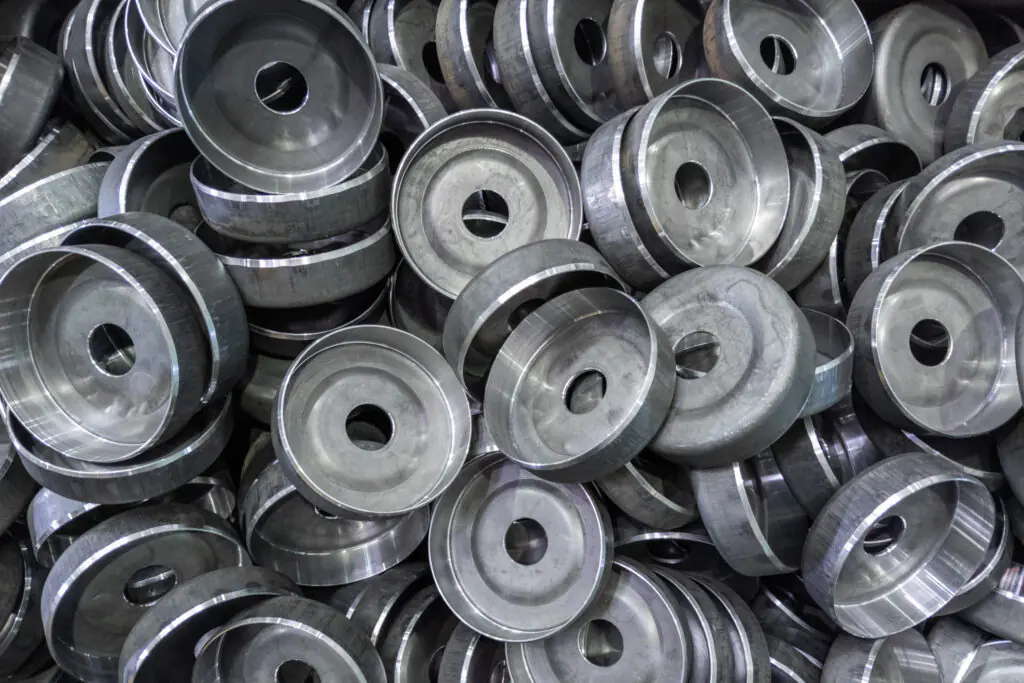
Dominando el proceso de estampación de metales: una guía completa sobre las prensas de estampación y el proceso de estampación
Este artículo proporciona una descripción general completa de Estampado de metal, centrándose en la proceso de estampación y el papel crucial de la prensa de estampaciónProfundiza en las complejidades de esta técnica de fabricación esencial, explicando cómo funciona, sus ventajas y sus diversas aplicaciones. Tanto si es ingeniero, fabricante o simplemente siente curiosidad por saber cómo se fabrican los objetos de metal cotidianos, esta guía ofrece información valiosa sobre el mundo de la fabricación de objetos metálicos. Estampado de metal, por lo que es una lectura que vale la pena para cualquier persona interesada en este campo industrial fundamental. proceso.
Tabla de contenido
¿Qué es el estampado de metal y cómo funciona?
Estampado de metal es una empresa manufacturera proceso utilizado convertir plano láminas de metal en formas específicas. Es un proceso de conformado en frío que utiliza herramienta y superficies de matriz para formar el metalEl proceso comienza con la materia prima, generalmente un metal bobina o blanco, que se coloca en un prensa de estampación. Dentro de la prensa, el herramienta y morir de la metal dentro del forma deseadaEsto puede implicar varias operaciones como punzonado, troquelado, doblado, acuñado, estampado y rebordeado.
El proceso de estampación Es conocida por su eficiencia, especialmente en producción de alto volumenEs capaz de producir formas complejas con alta precisión y repetibilidad, lo que lo hace adecuado para una amplia gama de aplicaciones, desde pequeños componentes electrónicos hasta grandes paneles de carrocería de automóviles. Estampado de metal Es un proceso versátil que puede funcionar con una variedad de materiales metálicos, incluidos acero, aluminio, cobre y latón. Puedes ver Estampado de metal en acción en el Estampado de metal página. La versatilidad y eficiencia de Estampado de metal convertirlo en una piedra angular de la fabricación moderna. proceso de formación juega un papel crucial en numerosas industrias.
Explorando los diferentes tipos de prensas de estampación
Prensas de estampación son los caballos de batalla de la Estampado de metal proceso. Estos máquinas aplicar la fuerza necesaria para dar forma a la pieza en blanco de metal usando un herramienta y morir. Hay dos principales tipos de prensas de estampación: prensas mecanicas y prensas hidráulicas.
Prensas mecánicas Utilice un volante accionado por motor para almacenar energía y transferirla al ariete, que luego fuerza al motor a moverse. herramienta dentro del pieza en blanco de metalSon conocidos por su velocidad y son adecuados para producciones de gran volumen. Prensas hidráulicasPor otro lado, utilizan presión hidráulica para mover el ariete. Ofrecen un mayor control sobre el recorrido y suelen emplearse para operaciones de embutición profunda o para trabajar con materiales más gruesos. Prensas hidráulicas Puede generar fuerzas mucho mayores que prensas mecanicas, pero suelen ser más lentos. La elección entre un prensa mecánica y un prensa hidráulica Depende de lo específico estampado solicitud, incluido el tipo de metal, la complejidad de la pieza y el volumen de producción requerido. Algunas operaciones utilizan herramienta y juegos de matrices.
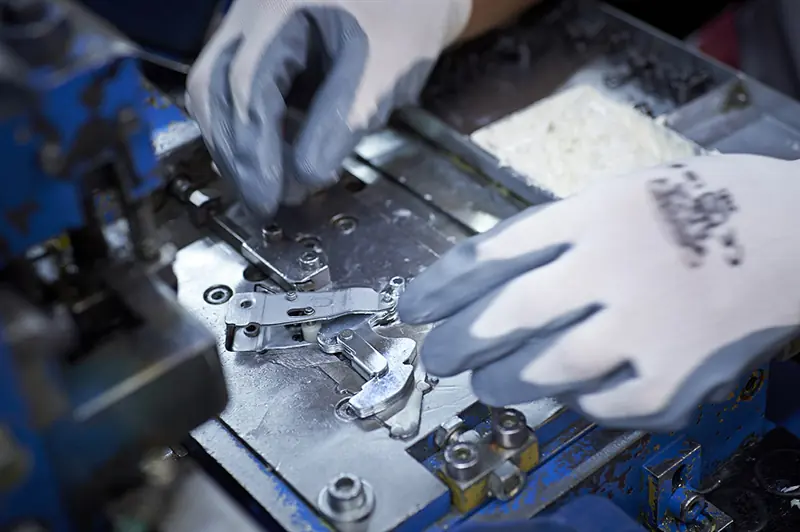
¿Cuáles son los tipos comunes de operaciones de estampado?
Varios tipos comunes de estampación Las operaciones se utilizan en Estampado de metal, cada uno de los cuales cumple una función específica a la hora de dar forma a la pieza de metalEstas operaciones se pueden realizar de forma individual o combinada, según la complejidad de la pieza y el resultado deseado. A continuación, se presentan algunas de las técnicas más habituales:
- Supresión: Esta operación implica cortar la chapa de metal para crear el contorno o silueta de la parte deseada. La pieza cortada, o blanco, se utiliza luego para su posterior procesamiento. La periferia del corte es el contorno final de la pieza.
- Puñetazos: Similar al troquelado, pero la parte recortada es de descarte y el resto tira de metal avanza a la siguiente operación. La perforación crea agujeros u otras formas en el chapa de metal.
- Doblado: Como sugiere el nombre, esta operación implica doblar el metal a lo largo de un eje recto para crear ángulos o curvas.
- Acuñación: Este proceso utiliza alta presión para crear características elevadas o hundidas en el metal superficie, como letras, logotipos o diseños intrincados.
- Realce: De manera similar a la acuñación, el estampado crea un diseño en relieve en el metal superficie, a menudo con fines decorativos o de identificación.
- Dibujo: Esta operación forma el metal en una pieza cilíndrica o con forma de caja pasándola a través de un troquel.
- Borrado fino: Proporciona bordes excepcionalmente suaves y tolerancias ajustadas, utilizado para piezas de precisión.
Estos son solo algunos ejemplos De los muchos estampado Operaciones que se utilizan en la industria. Cada operación requiere herramientas y experiencia específicas para garantizar que se logre el resultado deseado.
Comprender el papel de las herramientas y matrices en el estampado de metales
En Estampado de metal, el herramienta y la matriz son componentes esenciales que determinan la forma y la calidad de la pieza terminada. herramienta, también conocido como punzón, es el componente masculino que aplica fuerza al pieza en blanco de metalLa matriz es el componente hembra que soporta el metal y proporciona la forma deseada.
El diseño y construcción de la herramienta y morir son fundamentales para el éxito de la proceso de estampación. El El diseño debe Tenga en cuenta factores como el tipo de metal, la complejidad de la pieza, las tolerancias requeridas y la prensa de estampación siendo utilizado. Matrices de estampación Por lo general, están hechos de acero endurecido para soportar las altas presiones y fuerzas repetitivas involucradas en estampadoUn diseño bien diseñado herramienta y el juego de matrices puede producir miles o incluso millones de piezas con calidad y precisión constantes. herramienta y los troqueles suelen estar hechos a medida para cada pieza específica, lo que hace que Estampado de metal personalizado Un campo especializado que requiere un alto nivel de experiencia. Un mal diseño herramienta dará como resultado un componente mal hecho.
¿Qué es la estampación progresiva y en qué se diferencia de otros métodos?
Estampación con troqueles progresivos es un Conformado de metales método que utiliza una serie de estaciones de estampación realizar múltiples operaciones en un tira de metal. A medida que la tira se mueve a través de la matriz progresiva, cada estación realiza un corte diferente, puñetazo, doblado u otra operación. Esto permite la creación de piezas complejas con alta precisión y eficiencia. Es una operación muy específica tipo de estampación.
En comparación con otros métodos de estampación, como de una sola etapa estampado donde cada operación requiere una operación separada prensa y morir, Estampación con troquel progresivo ofrece varias ventajas. Es más rápido porque se realizan múltiples operaciones simultáneamente, es más rentable para producción de alto volumen. Este método de estampación Reduce el desperdicio de material porque la pieza permanece adherida a la tira de metal hasta la etapa final. Sin embargo, Estampación con troquel progresivo requiere un proceso más complejo y costoso herramienta y la configuración de la matriz. La inversión inicial es mayor, pero los ahorros de costos a largo plazo pueden ser significativos para grandes tiradas de producción. matriz progresiva En sí mismo es una maravilla de la ingeniería, con cada estación cuidadosamente diseñada y sincronizada para funcionar en armonía con las demás. Es un sistema más complejo. operación de estampación.
¿Cómo utiliza la industria automotriz la estampación de metal?
El automotor La industria es uno de los mayores usuarios de Estampado de metal. Este proceso de formación Se utiliza para crear una amplia gama de componentes de vehículos, desde paneles de carrocería y piezas estructurales hasta soportes y ménsulas más pequeños. ejemplo es sellado Los paneles de las puertas de los automóviles, que se moldean a partir de piezas planas láminas de metal usando grande prensas de estampación y matrices especializadas.
Estampado de metal ofrece varias ventajas para automotor Fabricación. Permite la producción de piezas ligeras pero resistentes, lo que contribuye a la eficiencia del combustible y la seguridad. También es un método rentable para producir grandes cantidades de piezas idénticas con alta precisión, lo que es esencial para la producción en masa de vehículos. automotor La industria depende de Estampado de metal para cumplir con sus estrictos estándares de calidad y demandas de producción. Los avances en Estampado de metal Tecnología, como el uso de aceros avanzados de alta resistencia y automatización. prensas de estampación, siguen impulsando la innovación en la fabricación de automóviles. Muchas empresas automovilísticas utilizan Estampado de metal personalizado para piezas específicas.
¿Cuáles son las consideraciones clave en el estampado de metal personalizado?
Estampado de metal personalizado implica crear algo único partes de metal Adaptado a los requisitos específicos del cliente. Este Proceso de fabricación A menudo requiere una estrecha colaboración entre el cliente y el estampador de metal para garantizar que el producto final cumpla con las especificaciones deseadas. Hay varias consideraciones clave que entran en juego Estampado de metal personalizado proyectos.
En primer lugar, el diseño de la pieza debe optimizarse para el proceso de estampaciónEsto implica tener en cuenta factores como las propiedades del material, la complejidad de la forma y las tolerancias requeridas. En segundo lugar, herramienta y el troquel debe diseñarse y fabricarse según los estándares más altos para garantizar la precisión y la consistencia del producto. sellado partes. En tercer lugar, la adecuada prensa de estampación y otros equipos deben seleccionarse en función de los requisitos específicos del proyecto. Por último, deben implementarse medidas de control de calidad en todo el proceso. proceso de estampación para garantizar que las piezas terminadas cumplan con las especificaciones del cliente. Estampado de metal personalizado requiere un alto nivel de experiencia y atención al detalle. Hay muchos servicios de estampación de metales disponible.
¿Qué implica el proceso de fabricación de metales?
Fabricación de metales Es un término amplio que abarca varios procesos utilizados para dar forma, cortar y ensamblar. metal en un producto final. Estampado de metal es sólo una de las muchas técnicas utilizadas en Fabricación de metales. Otros comunes fabricación Los procesos incluyen corte, doblado, soldadura, mecanizado y acabado.
Lo específico Proceso de fabricación El uso depende del tipo de metal, la forma y el tamaño deseados de la pieza y las tolerancias requeridas. ejemploEl corte se puede realizar mediante diversos métodos, como cizallamiento, aserrado, corte por láser o corte por plasma. El plegado se puede lograr mediante prensas plegadoras u otras máquinas de plegado. máquinasLa soldadura se utiliza a menudo para unir múltiples metal piezas juntas. Las operaciones de mecanizado, como el fresado, el taladrado y el torneado, pueden refinar aún más la forma y las dimensiones de la pieza. El producto terminado de la Fabricación de metales A menudo es un componente que se utiliza para fabricar un producto más grande.
El Proceso de fabricación A menudo comienza con dibujos de ingeniería o modelos CAD que proporcionan especificaciones detalladas para la pieza. Estos diseños guían la selección de materiales, la elección de fabricación técnicas y la secuenciación de operaciones. Fabricación de metales A menudo implica una combinación de diferentes procesos para lograr el producto final. ejemplo, un recinto de metal podría implicar cortar chapa de metal a medida, estampado o perforar agujeros y otras características, doblar el metal para dar forma al recinto, soldar las costuras y aplicar un acabado. Caja de estampación de chapa de acero Es un buen ejemplo.
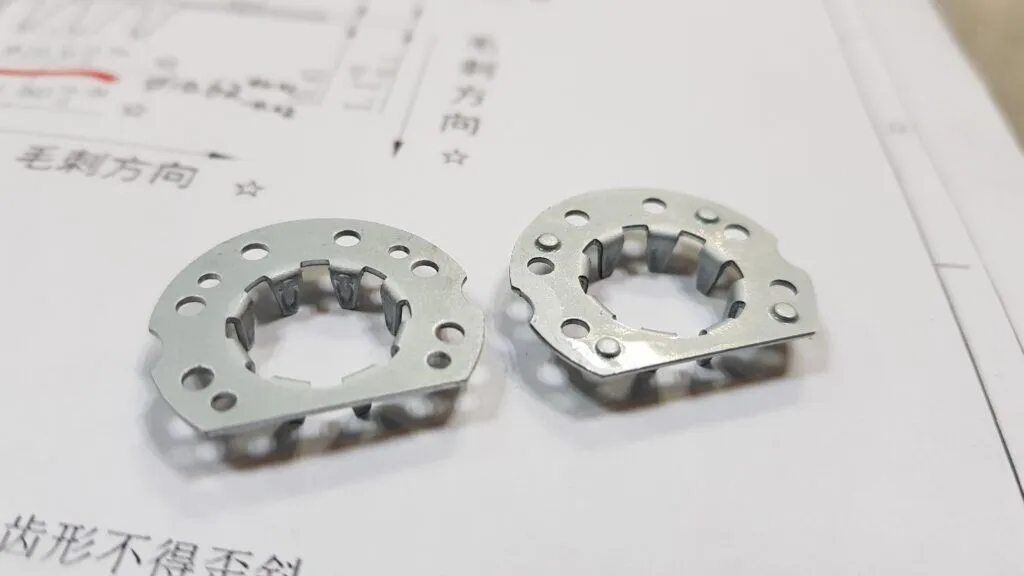
Explorando diferentes tipos de prensas de estampación: mecánicas e hidráulicas
Como se mencionó anteriormente, hay dos principales tipos de prensas de estampación:mecánico y prensas hidráulicasCada tipo tiene sus propias características, ventajas y limitaciones únicas, lo que los hace adecuados para diferentes aplicaciones de estampación.
Prensas mecánicas Son conocidos por su velocidad y eficiencia. Utilizan un volante para almacenar energía y un embrague para acoplar el motor. prensa accidente cerebrovascular. Por lo general, son más rápidos que prensas hidráulicas y son muy adecuados para producción de alto volumen de piezas más simples. Sin embargo, ofrecen menos control sobre el recorrido y la fuerza en comparación con prensas hidráulicasEl tonelaje, o capacidad de fuerza, de un prensa mecánica es más alto en la parte inferior de la carrera, lo que los hace menos ideales para operaciones de embutición profunda o conformado que requieren una fuerza constante a lo largo de la carrera.
Prensas hidráulicasPor otro lado, utilizan cilindros hidráulicos para generar fuerza. Ofrecen un mayor control sobre el prensa carrera, velocidad y fuerza, lo que los hace adecuados para una gama más amplia de aplicaciones, que incluyen embutición profunda, formación de formas complejas y trabajo con metales más gruesos o de alta resistencia. materiales metálicos. Prensas hidráulicas Pueden proporcionar una fuerza constante durante toda la carrera, lo que resulta ventajoso para determinadas operaciones de conformado. También son capaces de manejar tonelajes más elevados que prensas mecanicasSin embargo, suelen ser más lentos que prensas mecanicas y puede requerir más mantenimiento. Puede obtener más información sobre prensas hidráulicas en el Disipador de calor de aluminio personalizado página.
Comprender el papel del troquelado fino en el estampado de precisión de metales
Corte fino es una empresa especializada proceso de estampación que produce piezas con bordes excepcionalmente suaves, tolerancias ajustadas y alta precisión. A diferencia de los estampado, que puede dejar bordes ásperos o cortados, supresión fina Crea piezas que a menudo no requieren operaciones de acabado secundarias, lo que lo convierte en un proceso ideal para producir piezas de precisión. componentes metálicos Se utiliza en industrias como automotor, aeroespacial y dispositivos médicos. Este El proceso es a menudo Más lento que otros métodos.
El supresión fina El proceso utiliza una triple acción especializada. prensa que incorpora un anillo de impacto en forma de V para sujetar el metal firmemente en su lugar durante la operación. Esto evita que la metal desgarros o deformaciones, dando como resultado un producto limpio, bordes afilados. Corte fino Puede producir piezas con tolerancias tan estrechas como +/- 0,01 mm y una planitud de hasta 0,005 mm, dependiendo del material y la geometría de la pieza. Es especialmente adecuado para producir piezas pequeñas e intrincadas con formas complejas.
Mientras supresión fina Ofrece una precisión y una calidad de borde superiores, por lo general es más caro que los convencionales. estampado Debido a que se requieren equipos y herramientas especializados, la eliminación de operaciones secundarias, como el desbarbado o el rectificado, a menudo puede compensar los costos iniciales más elevados, lo que lo convierte en una solución rentable para ciertas aplicaciones. proceso de formación Se utiliza cuando se necesita alta precisión.
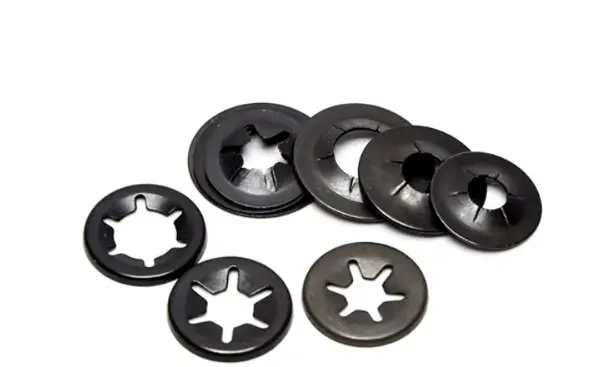
Conclusiones clave:
- Estampado de metal Es versátil Proceso de fabricación que utiliza prensas y matrices para transformar piezas planas láminas de metal en las formas deseadas.
- El proceso de estampación implica varias operaciones como troquelado, punzonado, doblado, acuñado y embutido, que pueden realizarse individualmente o en combinación.
- Prensas de estampación Son mecánicos o hidráulicos, cada uno con sus propias ventajas y limitaciones en términos de velocidad, fuerza y control.
- Estampación con troqueles progresivos es un método altamente eficiente que realiza múltiples operaciones en un tira de metal a medida que avanza a través de una serie de estaciones de estampación.
- El automotor La industria es un importante usuario de Estampado de metal, empleándolo para producir una amplia gama de componentes, desde paneles de carrocería hasta piezas estructurales.
- Estampado de metal personalizado implica crear algo único partes de metal Adaptado a los requisitos específicos del cliente, requiriendo un diseño cuidadoso, herramientas y control del proceso.
- Fabricación de metales abarca varios procesos, incluidos el corte, el doblado, la soldadura, el mecanizado y el acabado, que a menudo se utilizan en combinación para crear un producto final.
- Corte fino es una empresa especializada proceso de estampación que produce piezas con bordes excepcionalmente suaves y tolerancias ajustadas, ideales para componentes de precisión.
- La elección entre diferentes estampado métodos y prensa Los tipos dependen de factores como las propiedades del material, la complejidad de la pieza, el volumen de producción y consideraciones de costo.
- El proceso de estampación de metal Es un proceso complejo.
- Estampado de metal es muy importante Proceso de fabricación.
- Hay muchos diferentes tipos de prensas de estampación.
- Piezas estampadas para iluminación embutidas profundamente son un muy buen ejemplo de un producto elaborado utilizando proceso de estampación de metal.
- El proceso de estampación de metal Se utiliza en muchas industrias diferentes.
Al comprender las complejidades de Estampado de metalDesde los diferentes tipos de prensas y operaciones hasta las técnicas especializadas como el troquelado fino, los fabricantes pueden tomar decisiones informadas para optimizar sus procesos de producción y lograr la calidad y eficiencia deseadas para sus aplicaciones específicas. Este conocimiento es crucial para cualquier persona involucrada en el diseño, la producción o la adquisición de componentes metálicos.


